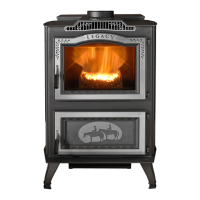11
Do Not Burn Wet Coal!
Super-Magnum Coal Stoker Stove
3-90-02702R8_11/13
5
Chimneys & Venting
A. Draft
Draftiswidelymisunderstood.Itisimportantthatyou,the
stoveoperator,realizethatdraftisavariableeffect,nota
givenquantity.Stovesandchimneysdonothavedraft,yet
draftisthekeytoyourstove’sperformance.
Draft is a force, produced by an operating stove and the
chimneytowhichitisattached.Itiscreatedbyhotgases
risingupthechimney,creatingapressuredifferencebetween
theinsideofyourhomeandtheoutsideair.Itcontinually
movesfreshcombustionairintothestove,andhotexhaust
gasesoutofthestove;withoutthisconstantow,there
will go out.
Other factors, such as barometric pressure, winds, the
tightness of the home, the total inside chimney volume,
chimneyheightandthepresenceofventingdevicessuch
asexhaustfansalsoplayaroleinmaintaininganadequate
draft. Low barometric pressures, super insulated homes,
andexhaustfanscan reduce draft;windscanplayhavoc
withdraft;andtoolargeortoosmallachimneyvolumecan
cause reduced draft due to the excessive cooling or not
enoughroomtoventtheexhaustgases.Introducingoutside
airdirectlytothestovemayhelpremedyalowdraftproblem.
Somesignsofinadequatedraftaresmoking,odor,difculty
inmaintainingthere,andlowheatoutput.Overdraftcanbe
causedbyaverytallchimneyevenifitistherecommended
size, and can cause overring of your stove. Signs of an
overdraft include rapid fuel consumption, inability to slow
there,andpartsofthestoveorchimneyconnectorglowing
red.Itisimportantthatyoufollowthechimneyguidelinesin
thismanual,includingsize,type,andheighttoavoiddraft
problems.
Wheninstalledandoperatedaccordingtothismanual,this
unit will produce enough hot gases to keep the chimney
warmsothatadequatedraftismaintainedthroughoutthe
burncycle.
B. Chimney Connectors
Abarometricdamperisrecommendedforchimneysover15
feethigh,andmaybenecessarytoprevent over-drafting.
Installitintheconnector,approximately12inchesabovethe
ueexit.Thebarometricdampershouldbesetsothatthe
uedraftwillmaintain-.06to-.08inchesofwatercolumn.
The appliance may be installed with (.6 mm) 24 gauge
chimneyconnectorpipe.Thesizeoftheconnectorshould
be6inchtomatchthesizeoftheuecollaropening.Do not
use makeshift components.
Nopartofthechimneyconnectormaypassthroughanattic
orroofspace,closetorotherconcealedspace,orthrough
a oor or ceiling. Whenever possible, avoid passing the
connectorthroughacombustiblewall;ifyoumust,usean
approvedwallpass-through,describedlaterinthissection.
Assembletheconnectorbeginningattheuecollar,withthe
crimpedendspointingtowardsthestove(tokeepdebrisand
creosoteakesinsidethesystem).Eachjoint,includingthe
onetothestove’suecollarandtheonetothechimneyitself
shouldbesecuredwithatleastthreesheetmetalscrews,
amaximumof3inchesapart.A1-1/4"(32mm)overlapis
requiredateachjoint,includingtheuecollarattachment.
Nomorethantwo90degreeelbowsshouldbeused,andthe
totallengthofconnectorshouldnotexceed10feet(3m)All
horizontalrunsofconnectormusthaveaminimumupward
slopeof1/4"perfoot(20mmpermeter).
C. Wall Pass-thrus
Itmaybenecessarytopassthechimneyconnectorthrough
acombustiblewalltoreachthechimney.Dependingonyour
localbuildingcodes,andprovincialornationalcodes,there
are several choices for accomplishing this safely. Before
beginning your installation, contact local ofcials, and the
chimneymanufacturerforspecicrequirements.
Canada: Three methods are approved by the CSA. The
diagramshowsonemethodrequiringan18"(460mm)air
spacebetweentheconnectorandthewall.Itallowsuseof
oneortwocoversasdescribedinthediagram.Theother
twomethodsaredescribedindetailinthecurrentissueof
CAN/CSAB365,thenationalstandard.
United States:ThenationalcodeisNFPA211.Besureto
checkwithlocalauthoritiesbeforebeginningyourinstallation.
The NFPA (National Fire ProtectionAgency) permits four
methodsforpassingthroughacombustiblewall.Acommonly
usedmethodtopassthroughawalldirectlytoamasonry
chimneyistoclearaminimum12"(305mm)aroundtheentire
chimneyconnector,andllitwithbrickmasonrywhichisat
least3.5"(90mm)thick.Areclayliner,minimum3/8"(9mm)
wallthicknessmustrunthroughthebrickwalltothechimney
liner(butnotbeyondtheinnersurfaceoftheliner).Itmust
becementedinplacewithrefractorycement.Thismethod
isillustrated.Fordetailsontheotherthreeoptions,referto
themostrecenteditionoftheNFPA211code.

